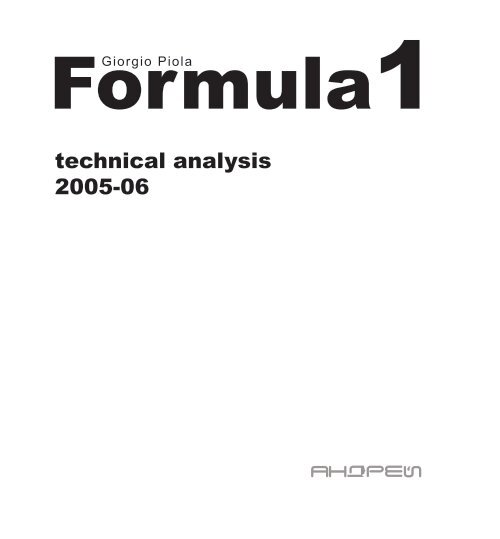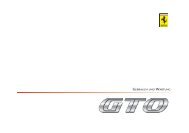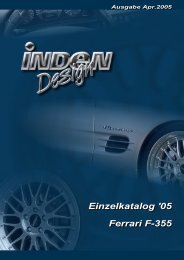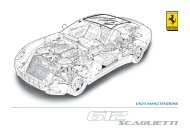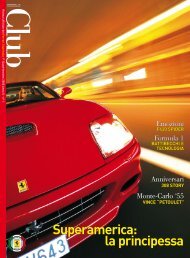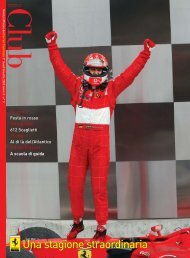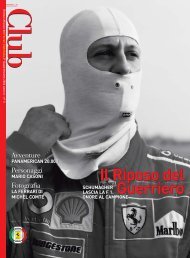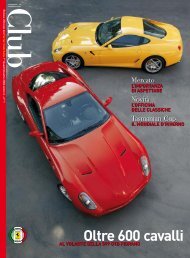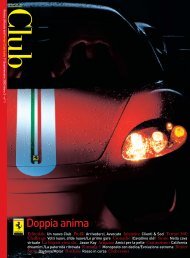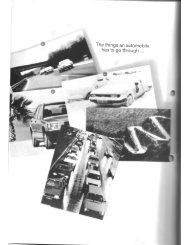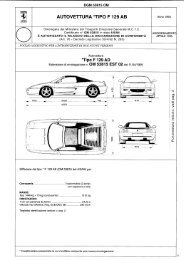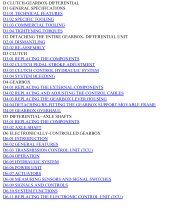Formula.1.Technical.Analysis.2005-06 - All Ferraris
Formula.1.Technical.Analysis.2005-06 - All Ferraris
Formula.1.Technical.Analysis.2005-06 - All Ferraris
You also want an ePaper? Increase the reach of your titles
YUMPU automatically turns print PDFs into web optimized ePapers that Google loves.
Formula1<br />
Giorgio Piola<br />
technical analysis<br />
2005-<strong>06</strong>
2<br />
01 Australia Grand Prix<br />
Toyota TF105 -<br />
additional winglets and profiles<br />
Additional wing profile (1) has been placed on top-front edge<br />
of sidepod, similar to that last year on Jordan EJ14. Main<br />
purpose is to increase downforce in this area of the car, but<br />
also divides airflow coming from the front wing into two,<br />
aiding engine cooling slightly. Addition of small winglets (2)<br />
on top of flip ups ahead of rear wheels - show how crucial<br />
downforce is above rear axle level to improve the car’s grip.<br />
Williams FW27 - additional bi-plane wing<br />
Addition of a very small wing, 10 cm wide, right over rear<br />
light support. Features a double profile with very high wing<br />
inclination, so as to assure a small but effective amount of<br />
downforce. Could be used as soon as Saturday qualifying in<br />
Melbourne, but in general only likely to be adopted on slow<br />
twisty circuits where traction is paramount.<br />
Williams FW27 - new turning vanes<br />
Gone are the horizontal fins attached to the central part of<br />
the car’s stepped bottom. Instead they have morphed into<br />
pointed extensions to the sidepods, almost resembling a knife<br />
blade. These vanes split the airflow in two, with the lower part<br />
directed to the bottom of the car, and the upper part diverted<br />
over the stepped bottom and around the lower section of the<br />
sidepod, adding a good amount of downforce.
Ferrari F2004 M - new front-wing endplates<br />
This design sports a flat, knife-edge profile instead of the<br />
curved section that was seen during pre- season testing. This<br />
change improves the efficiency of the front wing and reduces<br />
the turbulence generated by the front wheels.<br />
Sauber C24 - new engine cover<br />
The most visible change on the Sauber in Melbourne is a new<br />
engine cover which features a sort of vertical fin on its top, so<br />
as to direct the air flow to the rear wing more efficiently. The<br />
Renault R24 was the first car to sport such a solution and other<br />
teams may yet follow the lead.<br />
Red Bull RB01 - front wing<br />
This wing coupled to the very well refined profile of the<br />
sidepods has made the RB01 much more stable in comparison<br />
to its predecessor, the Jaguar R5. The deep spoon profile at<br />
the centre and the sinuous side sections provide a very good<br />
amount of downforce, notwithstanding the 2005 rules which<br />
require the front wing to be higher from the ground.<br />
3
4<br />
02 Malaysia Grand Prix<br />
Sauber C24 - radiators<br />
The C24 features sidepods with an extremely narrow bottom<br />
section – a design feature great for improving airflow<br />
management and downforce, but not so great for engine<br />
cooling (and hence reliability). The answer? Innovative<br />
V-shaped radiators, allowing for reduced sidepod height and<br />
excellent cooling – so good in fact that no further gills have<br />
been added for the very hot Malaysian race.<br />
Red Bull RB01 - sidepods and chimneys<br />
A more traditional cooling solution than seen on the Sauber in<br />
Malaysia. Already large chimneys have grown even further to<br />
ensure adequate heat dissipation in the extreme temperatures<br />
at Sepang. Despite the chimneys’ huge volume, their design<br />
does not appear to significantly disrupt airflow to the rear of<br />
the car.<br />
Williams FW27 - new barge boards<br />
An aero development for Sepang in the form of new barge<br />
boards (2), coupled with the horizontal, knife-blade profiled<br />
turning vanes (1) already seen in Melbourne. The change<br />
improves airflow management in this area, increasing cooling<br />
capability – paramount at this race. It should also increase the<br />
stability of the FW27, which has looked somewhat nervous<br />
over bumps and under braking.
McLaren MP4-20 -<br />
strengthened barge boards<br />
In Australia Kimi Raikkonen lost his right-hand barge board<br />
through contact with a kerb. So, for Sepang onwards, the<br />
mounting of this element on the front bottom edge of the<br />
sidepod has been strengthened, by increasing its width and<br />
adding layers of carbon fibre around it. Note also how the<br />
chimneys on the sidepod are increased in section due to the<br />
increased cooling needs at this track.<br />
Toyota TF105 - new front wing<br />
An evolutionary design for Sepang, sporting a much deeper<br />
central spoon profile (red arrow) than its predecessor. The<br />
spoon now features a continuous curve, rather than the<br />
partially flat section seen before. The extremities of the wing<br />
are now slightly higher than the central section, improving the<br />
efficiency of the endplates. A new flap (black arrow) has been<br />
added with wider sections close to the endplates, producing<br />
additional downforce.<br />
BAR 007 - additional barge boards<br />
An evolution of BAR’s barge board and turning vane concept<br />
for Malaysia. Previously the front-axle level barge boards<br />
were separated from the turning vanes in front of the sidepods.<br />
Now the two are connected by additional low, tiny barge board,<br />
similar to that seen on the Williams. The changes improve the<br />
airflow management underneath the car, and engine cooling,<br />
directing more air to the sidepod intakes.<br />
5
6<br />
03 Bahrain Grand Prix<br />
Williams FW27 - front wing modifications<br />
The evolution of the FW27’s front wing continues in Bahrain<br />
with the small winglets inside the endplates reduced in section<br />
(previously they curved upwards on their inside edge). This<br />
small change is hugely important to the front-end balance of<br />
the car and hence to improved tyre wear and cornering. The<br />
reduced winglet width reflects the higher top speed at this<br />
track, where it is not necessary to increase the downforce level<br />
under braking.<br />
Sauber C24 - engine air filter<br />
The sand didn’t prove as big a problem as expected at last year’s<br />
inaugural Bahrain race, but the teams are still taking some<br />
additional filtering measures. A thicker air filter than normal<br />
features more layers and more lies to each layer, reducing its<br />
permeability and protect the precious V10 from even the tiniest<br />
grains, which can be just a few microns wide.<br />
Ferrari F2005 - barge boards<br />
Some changes to the new Ferrari for Bahrain from the launch<br />
version. At the bottom of the barge boards a horizontal fin<br />
added (1), similar to that on the Renault R25, creating a sort of<br />
splitter for the outermost portion of the airflow, part of which<br />
it directs under the floor of the car to maximise the downforce<br />
generated. The saw-tooth profile on the bottom of the barge<br />
boards has been retained.
Ferrari F2005 - cooling chimneys<br />
Another obvious change on the F2005 for Bahrain is the<br />
chimneys on top of the sidepods. These have replaced the<br />
tiny vertical fins seen on the launch car. Of course, the main<br />
function of these is to improve the car’s cooling capabilities<br />
in the desert heat, but they also have an aerodynamic function,<br />
diverting airflow and acting in conjunction with the small<br />
winglets that have been added behind them, in a similar<br />
fashion to on the old (F2004 M) car.<br />
Ferrari F2005 - additional wing<br />
For Bahrain, Ferrari have added a small wing on top of the rear<br />
light support, similar to the solution introduced by Williams<br />
in Australia. It provides some highly effective additional<br />
downforce over the rear axle, improving the traction of the<br />
car. Sauber too have adopted a similar design here, now that it<br />
has passed the mandatory FIA crash tests.<br />
Renault R25 - front barge boards<br />
A very complex design for Bahrain. Three elements are kept<br />
together by two horizontal edges and are separated from<br />
eachother by vertical gills that split the airflow into three<br />
portions, all directed outwards to reduce the turbulence<br />
generated by the front wheels and to increase the airflow,<br />
and hence downforce, underneath the car. The result is a very<br />
aerodynamically stable Renault R25.<br />
7
8<br />
04 San Marino Grand Prix<br />
Ferrari F2005 - modified rear wing endplates<br />
For Imola these sport a square cut on their top rearmost edge, so<br />
as to reduce drag at high speeds. The design resembles closely<br />
that on the Renault R25, even though the concept is completely<br />
different, with the Renault one believed to rely more on clever<br />
use of the wing material’s elasticity.<br />
Renault R25 - front wing<br />
An interesting change for Imola. Two large horizontal flaps<br />
have been placed over the main wing profiles, with the inner<br />
edge connected by a thin pillar and the outer edge joined to<br />
revised endplates. This provides a huge amount of additional<br />
downforce, but adds surprisingly little drag - important at this<br />
circuit, with its high speeds and heavy braking zones.<br />
McLaren MP4-20 - brakes<br />
Imola is tough on brakes, so power and cooling is paramount,<br />
leading many teams to adopt McLaren’s solution of radial,<br />
square-section channels to improve bite. These increase friction<br />
between disc and pad, improving stopping power in the first<br />
part of the braking procedure. This initial power is crucial,<br />
because as the car slows further, decreasing downforce cuts<br />
braking efficiency.
Minardi PS05 - double-plane winglets<br />
Imola sees the debut of Minardi’s new car, totally different<br />
in concept to its PS04 predecessor. The lower sections of its<br />
sidepods are very narrow, as is the car’s rear end, making it<br />
resemble the 2005 McLaren and Renault. The aerodynamics<br />
behind the project look strong and include these double plane<br />
winglets, completely new to Formula One.<br />
FIA - rear wing flexibility test<br />
After complaints about illegal use of flexible rear wings in the<br />
first rounds of the season the FIA has brought in more stringent<br />
testing in time for the San Marino race. With a 50 kilo traction<br />
(horizontal) load applied at three different points of the wing,<br />
an identical vertical load is now also applied at the same points<br />
to check whether the wing would flex up and down at speed - a<br />
tough test given the thinness of the wing at this point.<br />
Ferrari F2005 - optical engine inspection<br />
Ferrari, with technical partners Olympus, have developed a<br />
system to inspect inside the 055 engine without stripping it<br />
down. The spark plug cover is removed (B) and an optical probe<br />
(A) inserted with a miniaturised camera. This sends images to a<br />
screen with resolution 1.5 times that of a plasma or LCD unit,<br />
providing highly-detailed pictures of the V10’s inner workings.<br />
This tool is especially useful this year, now that engines must<br />
last two race weekends.<br />
9
10<br />
05 Spain Grand Prix<br />
Williams FW27 - side wind vents<br />
Barcelona’s strong sidewinds upset a car’s aerodynamic<br />
efficiency, hence teams seek to reduce sensitivity to them by<br />
minimising the side bodywork’s cross-sectional area. Many,<br />
such as Williams, include a deep cut in the rear of the engine<br />
cover to act as a venting channel, through which side winds can<br />
flow with minimal disruption to the car’s set-up.<br />
Barcelona - third damper and tyre wear<br />
The Circuit de Catalunya runs clockwise, with left-hand tyres<br />
under huge lateral loads. Suspension is vital in reducing the<br />
stress on tyres, with the third damper fundamental to setting up<br />
the front of the car properly. This damper also affects the rear,<br />
as it reduces the car’s roll and yaw sensitivity, allowing it to run<br />
with lower camber angles, increasing the tyres’ contact patch,<br />
hence reducing tyre wear.<br />
Barcelona - tyre dynamics and deformation<br />
The car is set up with a camber angle so that the tyre becomes<br />
perfectly vertical when cornering, maximising its contact patch.<br />
This angle change is due to the chassis’ roll and yaw movement<br />
- it rotates around the centre of roll (yellow and black dot).<br />
Furthermore, the lateral forces on the car when cornering (large<br />
red arrow) make it want to slide on its tyres. This is countered<br />
by the controlled deformation of the tyre shoulder (large yellow<br />
dot).
Ferrari F2005 -<br />
strengthened barge-board links<br />
A small barge-board change for Barcelona, effecting both the<br />
large shields in front of the sidepods and the smaller ones at the<br />
front-axle level. With the former, the bottom of the sidepod has<br />
now been given a forward extension similar to that introduced<br />
by McLaren after Melbourne. The link between sidepod and<br />
barge board is now a sort of neutral wing profile, improving<br />
airflow management in this area, while also increasing the<br />
structure’s strength.<br />
Renault R25 - front ‘ears’<br />
A small but interesting change for Barcelona -side ‘ears’, right<br />
over the push rod links. These have a similar function to the<br />
small winglets already seen on the Toyota TF105, the work of<br />
ex-Renault employee Mike Gascoyne. These ‘ears’ provide<br />
a small increase in frontal downforce and also provide better<br />
airflow management around the cockpit area.<br />
Ferrari F2005 - front barge boards<br />
An interesting change in Barcelona to the small, front barge<br />
boards. These now feature a wide, horizontal knife-edged<br />
profile (in yellow) to improve their sealing effect. Perhaps<br />
surprisingly, these front boards play a bigger influence on<br />
the car’s aerodynamic balance than the larger ones in front of<br />
the sidepods. This is because they directly receive the airflow<br />
passing through the front wing, and divert it under and outside<br />
the chassis to increase the efficiency of the bottom of the car.<br />
11
12<br />
05 Spain Grand Prix<br />
Williams FW27 - barge board development<br />
In Barcelona Williams adopted a revised version of their big<br />
shields, providing them with a different knife-edged profile at<br />
the bottom. They now sport a sharper ‘tooth’ shape, instead<br />
of the continuous profile seen previously. This change is not<br />
dissimilar to designs used by Ferrari and Renault, splitting<br />
airflow in this area to reduce vortices and at the same time<br />
improve efficiency around the bottom of the car.<br />
Ferrari F2005 - asymmetrical cooling vents<br />
For Barcelona, different cooling layouts on either side of<br />
the Ferrari. The right sidepod features an open chimney to<br />
improve sidepod radiator cooling, while on the left one the<br />
chimney has been switched with a closed fin, whose main<br />
task is to improve the airflow directed to the rear of the car.<br />
This unusual layout reflects the different the cooling needs on<br />
the Circuit de Catalunya - a track with a prevalence of right<br />
handers.
Toyota TF105 - new turning vanes<br />
A change for Barcelona right in front of the sidepods. Gone is<br />
the single horizontal fin featured since Melbourne. In its place<br />
is a double element, with the outer part inclined downwards,<br />
and the inner one sporting a deeply-curved upward profile.<br />
These elements are part of a continuous development of the<br />
TF105, providing more efficiency (and hence downforce)<br />
from the diffuser and the bottom of the car in general.<br />
Ferrari F2005 - revised diffuser<br />
For Spain the side walls of the diffuser have been extended,<br />
with vertical ends instead of sloped one (see yellow line). This<br />
allows for an additional profile (see red arrow) that creates a<br />
sort of double channel (one above the other). This provides<br />
more efficient air extraction from beneath the car, increasing<br />
the speed of airflow on exit. This generates additional<br />
downforce and should provide more rear-end stability.<br />
13
14<br />
<strong>06</strong> Monaco Grand Prix<br />
Monaco set-up - additional fins<br />
Many of the aero features traditionally reserved for the ultrahigh<br />
downforce Monaco circuit are now used everywhere<br />
thanks to the 2005 regulations. Examples are the mid-wings<br />
and additional profiles shown by the small, red arrows. This<br />
year in Monte Carlo, the teams are likely to concentrate on<br />
adding fins and winglets on the sidepods (yellow-circled area).<br />
Monaco set-up - dampers<br />
Monte Carlo’s bumpy circuit forces teams to use greater ride<br />
heights, close to those normally reserved for wet conditions.<br />
To absorb the bumps, damper (orange arrow) and torsion bar<br />
(in blue) settings are softer. This makes the car easier to drive<br />
in tight corners. The downside is reduced aero efficiency, but<br />
this is of little relevance here due to the low average speeds.
Monaco set-up - increased steering angles<br />
Negotiating Monaco’s tight confines requires greater steering<br />
angles (2) than normal (1). To allow for this, the front<br />
suspension is modified, cutting into the wishbones (yellow) to<br />
stop the wheel rims touching them. To compensate, additional<br />
carbon-fibre reinforcements keep the structure solid and<br />
ensure it withstands the huge stresses caused by the bumps<br />
and accelerative and braking forces.<br />
Toyota TF105 - additional front winglets<br />
To increase downforce at Monaco, extra winglets have been<br />
mounted using tiny pillars on top of the main front wing<br />
profiles. The concept is similar to Renault’s front wing at<br />
Imola, but the look is somewhat stranger, closely resembling<br />
elements normally atop sidepods. The effect is to add frontend<br />
sharpness to the car on entry to corners.<br />
15
16<br />
<strong>06</strong> Monaco Grand Prix<br />
Ferrari F2005 - front wing<br />
For Monaco the central ‘box wing’ loses its upper profile (2).<br />
This reduces the car’s pitch sensitivity under braking, and the<br />
small loss of front downforce is recovered by adding ballast<br />
inside the bottom of the nose cone. This has slightly changed<br />
the overall balance of the car, while maintaining its sharpness<br />
into corners, a quality paramount at this track. The largely<br />
unchanged endplates now sport a single, small horizontal<br />
winglet (1).<br />
Renault R25 - additional side winglets<br />
A completely revised Renault aero package for Monaco. The<br />
sidepod winglets have been doubled up, with an extra lower<br />
element (bottom red arrow). A small flap (top red arrow) has<br />
also been added to the rear of the upper winglet, connected<br />
by a new vertical endplate. <strong>All</strong> this provides vital additional<br />
downforce - crucial on the narrow streets of the Principality.
McLaren MP4-20 - front wing<br />
Aero changes for Monaco include the addition of a vertical<br />
fin under the main profile (in yellow), acting as an airflow<br />
splitter, and a change to the shape of the lower channel on the<br />
endplates (in orange). The channel now has a flatter upper edge<br />
(previously semi-circular). The modifications help reduce<br />
the car’s pitch sensitivity, improving its front-end sharpness,<br />
which is vital in the tight corners of Monte Carlo.<br />
Ferrari F2005 - front wheels ‘ears’ and<br />
horizontal disc holes<br />
A detail change for Monaco - a tiny, wing-like structure inside<br />
the top of the front-brake cooling drum. Two horizontal holes<br />
(blue arrows) allow air circulation, almost like small air<br />
intakes for the brake callipers. As the structure turns with the<br />
wheel it also acts as a mobile winglet, providing a small but<br />
constant increase in front grip. Its overall width is 12cm, the<br />
maximum allowed for brake air intakes. Another change is the<br />
holes in the edge of the brake disc, which now run across the<br />
edge rather than along it, with each an ‘eight’ shape rather than<br />
oval. These changes improve thermal heat exchange through<br />
the disc’s side walls.<br />
Red Bull RB01 - front suspension<br />
A new suspension layout for Monaco, with the upper front<br />
wishbone acting as a large wing profile, about 25 cm across<br />
at its widest section and 8 cm thick. This front arm, which<br />
includes the steering link, provides additional front-end<br />
downforce, invaluable at this twisty track.<br />
17
18<br />
07 Europe Grand Prix<br />
Sauber C24 - front wing endplates<br />
A change for the Nurburgring, seen briefly, but not raced<br />
at Monaco. The previously semi-circular section to the<br />
endplate’s lower channel now has a much flatter shape at its<br />
top, a solution not dissimilar to that seen on the McLaren in<br />
Monte Carlo. This revision reduces the pitch sensitivity of the<br />
car’s front end.<br />
Renault R25 - front wing endplates<br />
Introduced at Monaco, but retained for Europe due to their<br />
positive effect on the car’s front aero balance, these endplates<br />
feature a lower channel (red arrow), increasing the overall<br />
width of the wing. The channel has a vent hole at the rear<br />
allowing air to pass through (blue arrow), reducing turbulence<br />
and refining the airflow to the bottom of the car.
BAR 007 - new turning vanes<br />
For BAR’s return at the Nurburgring these follow a trend<br />
seen on other cars in recent races. The main turning vane<br />
is a horizontal fin, extending outwards from the outer-front<br />
edge of the sidepod (right-hand arrow). This is coupled with<br />
a horizontal, wing-shaped splitter at the same level (left-hand<br />
arrow). The aim is to improve the aerodynamic efficiency of<br />
the bottom of the car and is an area being constantly evolved<br />
by most teams this year.<br />
McLaren MP4-20 - barge board fins<br />
Adding small pointed fins to the external edge of barge boards,<br />
close to their sidepod link, has become increasingly popular<br />
since their first appearance on last year’s Renault at Monaco.<br />
At the Nurburgring McLaren have introduced a triangular<br />
fin on the right-hand barge board only. This asymmetrical<br />
approach is down to the track being clockwise (as most are)<br />
- the right side of the car is the most effected by the airflow<br />
directed beneath it in corners. The new fins help limit those<br />
effects.<br />
19
20<br />
07 Europe Grand Prix<br />
Sauber C24 - chimneys<br />
A curious chimney design for the European round. Curious<br />
because the top is closed, hence they don’t have the function<br />
of hot-air venting. Also curious because they are visibly<br />
curved outwards, not just inclined as on most cars. Their main<br />
function therefore looks to be diverting airflow outwards,<br />
away from the rear wheels, to reduce turbulence and refine<br />
the airflow impacting the rear wing.<br />
Jordan EJ15 - chimneys<br />
For the Nurburgring race Jordan adopted some of the largest<br />
cooling chimneys in the paddock. The only obvious reason<br />
is the weather, which has been much hotter and more humid<br />
than is typical for the region at this time of the year.
Williams FW27 - winglets<br />
Also seen in Monaco, Williams’ Nurburgring winglets<br />
are based on a series of double profiles. The fronter-most<br />
winglets (in blue, next to the cooling chimney) have a lower<br />
profile that also acts as the structure’s support mounting. The<br />
rearmost winglets (white) also sport a double profile at their<br />
rear, connected by a small vertical endplate. These changes<br />
are, of course, to optimise the aerodynamics at the rear of the<br />
car and to increase downforce.<br />
Renault R25 - rear-light wing<br />
Already seen on other cars, at the Nurburgring Renault<br />
introduced a small wing on top of the rear light. Roughly 15 cm<br />
wide, it is connected to the light cover and crushable structure<br />
by means of a tiny pillar. This device helps with the extraction<br />
of air from the bottom of the car by means of a depression that<br />
it creates right behind the rear diffuser’s central section.<br />
21
22<br />
08 Canada Grand Prix<br />
Renault R25 - new rear wing<br />
Small changes can bring big performance gains, hence this<br />
new design in Montreal. It may not look much different, but is<br />
in fact all new. The flap has been reduced in cross section and<br />
height, while the main profile is higher than before. Revisions<br />
to the endplates highlight the changes – their upper section is<br />
now narrower where it connects to the flap. The changes all<br />
relate to Canada’s medium downforce requirement and the<br />
top speed needed for the long straight preceding the short pit<br />
straight.<br />
BAR 007 - additional winglets<br />
New winglets for Montreal in front of the sidepods, not<br />
dissimilar to the ones introduced by Toyota a few races ago.<br />
The new element features a large endplate, bigger than the<br />
equivalent Toyota device. Interestingly, the new winglets are<br />
not just for slower circuits, but are expected to be a permanent<br />
feature on the car for the rest of the season. These elements<br />
provide additional downforce and help improve the airflow<br />
directed to the rear of the car.<br />
Red Bull RB01 - rear-wing endplates<br />
Red Bull introduced a rear wing featuring revised endplates<br />
for Montreal. In their detail they are now quite similar to those<br />
on the Williams FW27, as they sport a revised cut at their<br />
rearmost upper corner (red arrow), so as to reduce side-wind<br />
sensitivity and turbulence in the corners. The changes seem to<br />
improve the stability of the car’s rear end.
Ferrari F2005 - rear-wing endplates<br />
A revised design for the medium-downforce Circuit Gilles<br />
Villeneuve. The wing sports a revised flap, with reduced<br />
cross section, and revised endplates, with two, rather than the<br />
previous three, horizontal slits (right-hand arrow). With less<br />
downforce required, the main profile is higher than before.<br />
Also, the rear diagonal cut of the endplates has been reduced<br />
in width (left-hand arrow) to better manage the vortex created<br />
by airflow impact in this area.<br />
McLaren MP4-20 - front wing<br />
As in Monaco, in Montreal McLaren concentrated their aero<br />
efforts on the front wing, with revised endplates that now<br />
feature a small horizontal fin right at the level of the front<br />
edge (red arrow). This element is very similar to a solution<br />
adopted by Ferrari in recent races. It provides reduced pitch<br />
sensitivity to the front end of the car and helps prevent the<br />
rear being too twitchy on the entrance to corners.<br />
McLaren MP4-20 - brakes<br />
Montreal is hard on brakes, particularly with regards to<br />
keeping them cool. McLaren approached the problem in two<br />
directions, increasing the cross section of the round brake<br />
ducts (left arrow) and at the same time adopting a new material<br />
for the discs (right arrow). This material is capable of keeping<br />
the discs at the correct working temperature while at the same<br />
time reducing wear - so often a cause of brake failure and<br />
retirement here.<br />
23
24<br />
09 USA Grand Prix<br />
Williams FW27 - winglets & chimneys<br />
The FW27’s aerodynamics never stop evolving. For the US<br />
the rear of the sidepods have received particular attention,<br />
with interesting double winglets, the lower smaller winglet<br />
connected to the sidepod by a short horizontal link (left red<br />
arrow). This change is coupled with revised exhaust chimneys<br />
(right red arrow), designed to improve cooling in the infield<br />
section after the long run into turn 1.<br />
Williams FW27 - front wing<br />
A revised flap for the US (right arrow), without the pointed<br />
extension (left arrow) seen in the recent races. Indy set-ups<br />
usually favour the track’s high-speed section and this change<br />
indeed lessens drag and downforce. The lower section of the<br />
endplates are also newly rounded towards the rear to improve<br />
the wing’s efficiency close to the front wheels.<br />
Toyota TF105 - front wing<br />
This revised design is intended to reduce drag on the fast<br />
sections of the Indianapolis Motor Speedway. It features a<br />
narrower flap with a diagonal top profile (red arrow), reducing<br />
the cross section of the element (and hence drag) as much as<br />
possible. Single-lap performance has looked good - indeed,<br />
Toyota clinched their first ever pole in qualifying.
BAR 007 - rear wing<br />
A completely new design for the US. The upper profile<br />
and flap feature a dished, V shape, which has proved more<br />
efficient in terms of top speed in testing, at the same time<br />
maintaining clean and efficient airflow at exit, so as to help<br />
with air extraction from the rear diffuser. New endplates<br />
sport four curved diagonal gills, similar to those introduced<br />
by Toyota at the start of the season. These reduce turbulence<br />
around the inner edge of the endplates.<br />
Jordan EJ15 - double splitter<br />
Not entirely new, but an interesting feature at Indy. Just in<br />
front of the main splitter beneath the cockpit is an extra series<br />
of low barge boards (red arrow) with an almost V-shaped<br />
diverging profile joined by a horizontal plate. These elements<br />
work together with the horizontal turning vanes in front of the<br />
sidepods and the vertical sculpted shields at front-suspension<br />
level. They help manage airflow under the car, increasing<br />
downforce generated by the bottom of the car.<br />
Indianapolis Motor Speedway -<br />
banking effect<br />
Turn 13 at Indianapolis is the only real banked turn in Formula<br />
One racing and proved Michelin’s undoing. With an angle<br />
of up to nine degrees, it demands a left-right compromise<br />
on suspension set-up. The left tyres take the heaviest strain,<br />
particularly their shoulders, with tyre temperature increasing<br />
in this area as a result (red spot). If this temperature is too<br />
high for too long, wear rates rise dramatically and can lead<br />
to failure. The tendency for teams to run low tyre pressures,<br />
allowing them to use stiffer suspension settings, would only<br />
exacerbate the problem.<br />
25
26<br />
10 France Grand Prix<br />
Ferrari F2005 - additional nose fins<br />
The F2005 has undergone considerable development recently,<br />
and in France sports a large number of changes, mainly<br />
aerodynamic, focussed on delivering a better balance to the<br />
car. These additional inclined fins on the side of the nose<br />
cone are at the level of the upper suspension wishbone. They<br />
work together with the wishbone’s wing-shaped profile to<br />
effectively increase its surface. The fins therefore produce<br />
an increase in downforce on the front axle and also manage<br />
airflow to the rear of the car more efficiently.<br />
Ferrari F2005 - extra sidepod fins<br />
In addition to the main fins, at Magny-Cours the F2005 also<br />
boasts further aerodynamic elements on the sidepods (red<br />
arrow). These are inclined downwards with a rounded shape<br />
and have the same function as similar devices introduced in<br />
previous races by Toyota and BAR. They provide a small<br />
amount of additional downforce very close to the centre of<br />
the car, improving its aerodynamic stability. These elements<br />
are likely to be developed further as the season progresses.<br />
Renault R25 - additional rear wing<br />
In Magny-Cours most changes are aerodynamic, as the track<br />
is so flat that teams are able to run very low ride heights and<br />
thus maximise aero efficiency. The French Grand Prix is<br />
therefore an excellent place to show off aero kit evolution.<br />
Renault showed an interesting new development in the shape<br />
of a small rear wing placed on top of the rear crush structure<br />
of the R25, a clear development of the similar mini-wing<br />
introduced in Monaco. This one differs in height, and also its<br />
vertical side pillars have clearly been inspired by the similar<br />
Ferrari wing at the European Grand Prix.
McLaren MP4-20 - revised front wing<br />
It is often the small changes that make the big improvements.<br />
McLaren’s front wing has evolved slightly but significantly<br />
in Magny-Cours. Two races ago we pointed out different<br />
endplates featuring a short horizontal fin placed at the front.<br />
With the experience of racing and testing the team has now<br />
moved the mounting point of these fins back slightly. This, in<br />
addition to changed suspension settings, provides the car with<br />
improved stability and handling.<br />
McLaren MP4-20 - rear section<br />
Not completely new, but it’s fascinating to see how the rear end<br />
of the McLaren is revised between races. For Magny-Cours,<br />
the vertical fin placed inside the hollow section in front of the<br />
rear wheels now sports a more curved, sinuous shape. This<br />
improves the efficiency of this area by increasing the speed of<br />
the air passing through it, therefore improving the extraction<br />
of air from the diffuser.<br />
BAR 007 - front wing<br />
More incremental - but significant - changes to the BAR at<br />
Magny-Cours. The outside extremities of the main chord are<br />
raised even further, while the endplates boast a new, more<br />
pointy, exit edge. <strong>All</strong> these changes improve downforce and<br />
reduce pitch sensitivity, while the new endplates will cut drag.<br />
27
28<br />
11 Great Britain Grand Prix<br />
Ferrari F2005 - revised box wing<br />
At Silverstone Ferrari are running a new version of their front<br />
box wing, which provides the car with additional downforce. Its<br />
dimensions have increased and the endplates now have a larger<br />
area and extend under the main wing profile. Despite paddock<br />
speculation about its material composition, Ferrari confirm that it is<br />
manufactured from carbonfibre like the rest of the wing.<br />
Williams FW27 grows ears<br />
Renault did it some races ago and at Silverstone Williams have<br />
introduced two small ‘ears’ towards the front of the chassis. These<br />
slightly increase downforce on the front axle - and better manage<br />
the airflow to the rear of the car. The small change is a part of the<br />
substantial update package that Williams began to introduce in<br />
France in a quest for improved aerodynamic stability. Particular<br />
benefit is likely to be felt during sudden direction changes at high<br />
speed - like in the Becketts complex.<br />
Ferrrari F2005 - revised front wing endplates<br />
In addition to the new ‘box’ element under the F2005’s front wing,<br />
it also sports revised endplates for the British Grand Prix. These<br />
now feature a flatter upper profile, increasing their cross sectional<br />
area - as demonstrated by comparing new and old. Their function is<br />
to increase front downforce by better airflow management over the<br />
main wing profile, improving the efficiency of the small flap.
Williams FW27 - new sidepods<br />
The revised ‘B’ spec FW27 first seen in France has extensively<br />
modified sidepods, especially towards the rear. Gone are the<br />
previous, large exhaust chimneys. Vented horizontal gills take<br />
their place (1), similar to those used by Renault, allowing<br />
a smaller exhaust opening in the bodywork, reducing the<br />
disruptive effect on airflow. The double winglets behind the<br />
radiator chimneys have also been modified with a different<br />
layout, the rearmost, white, winglet now closer to the upper,<br />
blue, one (2). This is an effect of the reduced sidepod height,<br />
achieved with smaller radiators. Finally, in the gearbox area (3)<br />
the rear suspension features revised, more compact mounting<br />
of the upper wishbone, giving a cleaner airflow.<br />
Jordan EJ15B shows its secrets<br />
The substantially revised EJ15B, used only in Friday practice<br />
at Silverstone, is a huge development over the car that began<br />
the season. The sidepods have been completely revised,<br />
sporting a narrower section at the base and lower height at the<br />
rear. Exhaust position has also been changed to clean up the<br />
area next to the rear wing and improve overall aero efficiency.<br />
German race debut is possible.<br />
Sauber C24 follows the box wing route<br />
Delivery delays meant Sauber were only able to introduce<br />
their revised front wing from Saturday at Silverstone. It<br />
features a revised box section wing, similar in principle to<br />
the one adopted by Ferrari at the start of the season. Sauber’s<br />
element looks much thinner than Ferrari’s and is connected to<br />
the main profile by two tiny pillars. The function is the same<br />
- to provide additional downforce at the very front of the car,<br />
helping it to make rapid direction changes.<br />
29
30<br />
12 Germany Grand Prix<br />
Ferrari F2005 - barge board development<br />
Part of a new aero package for Germany - revised barge boards<br />
in front of the sidepods, sporting a more squared cross section.<br />
The extra fin (red arrow), introduced a few races back, has grown<br />
and works closely with the other fins at the front edge of the<br />
sidepods. This adds some downforce, but its main function is to<br />
clean up the air flow to the rear of the car, making for more stable<br />
handling.<br />
Red Bull RB01 - rear wing slits<br />
Seen at some previous races and back for Germany, these help<br />
reduce turbulence and increase the efficiency of the rear wing,<br />
hence raising rear grip - crucial for good traction exiting the<br />
hairpin after the sweeping left hander in sector two at Hockenheim.<br />
Increasingly popular, this solution was first introduced by Toyota<br />
at the start of the season.<br />
Toyota TF105 - front wing flap comparison<br />
Toyota are trying two front wing designs in Germany, featuring<br />
flaps with different widths and top-edge shapes. The wider flap<br />
(top arrow) extends very close to the central spoon, while the top<br />
edge of the narrower one (bottom arrow) descends towards the<br />
centre of the wing. The wider version adds downforce, but also<br />
makes the car more pitch sensitive. Which one to choose depends<br />
on the desired balance between the front and rear of the car and<br />
between top speed and braking stability.
McLaren MP4-20 - front wing development<br />
A completely new aero package for Germany. The front wing’s<br />
main profile loses 6cm in width, which is transferred to the<br />
bottom of the endplates, with their knife-edge rounded profile.<br />
The endplate’s horizontal fin, introduced in Canada, is also<br />
wider. The overall effect, combined with rear wing changes, is<br />
more downforce and sharper turn-in on faster corners.<br />
McLaren MP4-20 - rear wing development<br />
A hugely modified design for Germany. The all-new main<br />
profile still bends upwards, but its profile is narrower and is<br />
connected to completely revised endplates, featuring three<br />
horizontal slits (1), as seen now on many cars. The front edge<br />
of the endplate bends slightly rearwards (2) and the rear-most<br />
corner of the wing sports a deep cut, to reduce the turbulence<br />
generated by air exiting the main profile. Finally, the flap of the<br />
wing features a central Gurney tab (3) to increase downforce.<br />
Renault R25 - sidepod fin development<br />
In Germany, this additional fin, introduced a few races back,<br />
takes on a vertical edge at its rearmost point. This helps to<br />
manage even more accurately the way airflow is directed<br />
to the rear of the car, in particular over the side section of<br />
the diffuser. The 2005 rules have dramatically reduced aero<br />
efficiency and downforce in this area, so every little thing is<br />
considered in a bid to claw back the subsequent loss of grip.<br />
31
32<br />
13 Hungary Grand Prix<br />
Sauber C24 - chimney venting<br />
Sauber have two versions of their closed sidepod chimneys.<br />
This version for Hungary has double air vents on its inner<br />
edge which still allows some hot air to escape - useful with<br />
the hot, damp weather here. It is one of a number of changes<br />
on the car for this race. Among others is an extra Gurney tab<br />
on the rear wing’s exit profile, designed to provide extra grip<br />
out of this circuit’s tight, low-speed corners.<br />
Minardi PS05 - rear wing development<br />
Minardi introduced this new design in Hockenheim and have<br />
added a small wing on top of the rear crushable structure for<br />
Hungary. The main changes are the four rounded slits in the<br />
upper-front corner of the endplates, similar to those used by<br />
other teams this season to reduce turbulence. The endplates<br />
are now narrower at the top too, with a new curving profile at<br />
the bottom. The large vertical slit - Minardi were the first to<br />
introduce this last season - remains, lessening drag and raising<br />
the efficiency of the wing’s lower profile.<br />
Renault R25 - rear wing development<br />
A revised design for the tight, twisting Hungaroring, where<br />
downforce levels are higher than anywhere bar Monaco. A sawtooth<br />
profile to the Gurney flap (red arrow) adds downforce,<br />
but also helps in detaching the airflow as it leaves the exit<br />
profile of the flap. This helps ease the inevitable disruption<br />
caused by vortices generated by the high wing angles at this<br />
track. The three horizontal slits on the endplates also reduce<br />
turbulence and cut drag.
Toyota TF105 - triple mid wing<br />
In a bid to claw back downforce lost under the 2005<br />
regulations, Toyota adopted this solution in Hungary, where it<br />
is so desperately needed. The three wing elements are placed<br />
close together to create the effect of a one larger wing on top<br />
of the engine cover. Their position in the centre of the car<br />
means they do not upset the balance of the chassis, with no<br />
prevailing load towards the front or rear.<br />
Williams FW27 - triple mid wing<br />
As Budapest is a very twisty circuit, Williams adapted their<br />
aerodynamics accordingly. For the first time the FW27 sported<br />
a series of three mid wings to create additional downforce<br />
right at the centre of the car. This doesn’t cause any change to<br />
the overall aerodynamic balance, due to the central location,<br />
with no pre-eminence either to the front or rear downforce<br />
load.<br />
Red Bull RB01 - rear aero development<br />
Hungary saw Red Bull’s final major aerodynamic revisions<br />
to their RB01 machine before they switch their attentions to<br />
the detailed design process for next year’s car. Here, we see<br />
a revised engine cover, with even narrower sidepods sculpted<br />
inwards at the rear. This tighter rear-end packaging increases<br />
the overall aerodynamic efficiency of the car.<br />
33
34<br />
14 Turkey Grand Prix<br />
Williams FW27 - front wing<br />
Changes to the front end for Turkey, notably the wing. A<br />
double flap (left twin arrow) replaces the previous single one.<br />
This provides more downforce, but with only a minimal drag<br />
increase, as the flap angle remains low. The endplates are also<br />
revised. They are now inclined outwards at the base (bottomright<br />
arrow), similar to McLaren’s, and the side fin (top-right<br />
arrow) is longer and thinner.<br />
Renault R25 - front-wing development<br />
In Turkey, proof of how tiny changes can bring big gains. The<br />
Renault sports a revised version of the extra front-wing profile<br />
introduced at Imola. It now bends upwards towards the centre<br />
of the car. The endplate has also evolved at its fronter-most<br />
edge. A sharper corner (compare old and new yellow-shaded<br />
areas) creates a knife-edge profile. <strong>All</strong> these changes help<br />
improve front-end stability, especially under braking.<br />
Ferrari F2005 -<br />
winglet and chimney configuration<br />
With the exception of Hungary with its exceptionally high<br />
air temperatures, this almost definitive Ferrari configuration<br />
has been unchanged in recent races, with the closed chimneys<br />
serving not as cooling devices, but as splitters, acting in<br />
conjunction with the winglets to control airflow over the rear<br />
of the car. For Turkey, the main profile of the winglet partially<br />
crosses the chimney. In addition, all bodywork has gone on<br />
something of a diet to reduce surface area - in particular the<br />
outer side of the vertical fences inside the rear wheels and<br />
the rearmost section of the engine cover, over the suspension<br />
elements.
Williams FW27 - hidden engine venting<br />
Things are not always what they seem in Formula One racing.<br />
In addition to Williams’ Renault-style cooling gills, their<br />
bodywork in Turkey also has two large slits beside the engine<br />
heads, dissipating heat through a vent in front of the rear<br />
wheels. These are well hidden by the big upward-curving fin<br />
in front of the wheels. The solution prompts recollections of<br />
a Jordan exhaust-exit design seen last year. The Williams slits<br />
aid cooling without too much airflow disruption in this area.<br />
McLaren MP4-20 - additional fins<br />
Small but important changes in Turkey, continuing<br />
development of the barge boards and lower sidepods. Small,<br />
round-edged fins are added both to the outermost edge of the<br />
car’s flat bottom (lower-right arrow) and to the triangular fin<br />
connected to the barge boards (lower-left arrow). The knifeedge<br />
profile of the barge boards has also been lengthened<br />
slightly (upper-left arrow). <strong>All</strong> these changes help increase<br />
airflow efficiency underneath the car.<br />
Driver drinking system layout<br />
In the Turkish heat (which in the end was not as severe as<br />
expected) it is crucial that a driver can easily take on fluids.<br />
The usual system to provide this has three elements. The<br />
drink reservoir is placed low on the side of the cockpit, so<br />
as to prevent it raising the car’s centre of gravity. It usually<br />
contains around two litres of fluid (which means two kilos of<br />
extra weight at the start of the race). A pump, activated by the<br />
driver via a steering-wheel switch, sucks the liquid through a<br />
tube and to the driver’s mouthpiece inside his helmet.<br />
35
36<br />
15 Italy Grand Prix<br />
McLaren MP4-20 - front wing<br />
The fact that Monza is the only ultra fast circuit on the calendar<br />
is clearly visible in the small dimensions of the wing elements<br />
on all the cars here. Minimal downforce is needed and the high<br />
speeds mean this can be generated with very small flaps and<br />
fins. The McLaren sports a single front flap, rather than the<br />
usual double one, crucial for cutting drag as the cars approach<br />
370 kph on the main straight.<br />
Ferrari F2005 - front wing changes<br />
At Monza where speeds are high, drag is the enemy. To reduce<br />
it, teams tend to use narrower wing flaps. Ferrari have gone so<br />
far as to remove the extra box wing usually seen immediately<br />
below the F2005’s nose. The small loss in downforce (of<br />
minimal importance here) is more than offset by the resultant<br />
reduction in drag and increased top speed.<br />
Toyota TF105 - revised front wing<br />
Toyota have adopted very reduced wing elements for Monza<br />
because of the high top speeds on this track. Both front and<br />
rear wings feature very slim profiles, but especially the front<br />
one, with a very narrow flap that features two tiny vertical<br />
extensions at the extremities (red arrow).
Williams FW27 - closed rear-brake drums<br />
As first spotted on the grid in Istanbul, the brakes feature a<br />
sort of outer shell that completely covers the upright and the<br />
disc. The shell creates a semi-sealed area, which should cause<br />
air entering from the brake duct to circulate at a higher speed,<br />
hence improving cooling of the disc. The shell itself, however,<br />
is likely to get very hot, and there was speculation that this<br />
could have played a part in the team’s right-rear tyre failures<br />
during the Turkish race.<br />
BAR 007 - new turning vanes<br />
For Monza, BAR have increased the width of the horizontal<br />
turning vanes in front of the sidepods, so as to maximise the<br />
aerodynamic efficiency of the underbody. To this aim, the<br />
horizontal, triangular extensions immediately in front of the<br />
splitter, as seen in previous races (Click here for details), have<br />
been removed.<br />
37
38<br />
15 Italy Grand Prix<br />
BAR 007 - sidepod winglet reduction<br />
For Monza, the large endplates normally seen on the side fins<br />
in front of the rear wheels have been reduced in size. This<br />
not only cuts drag, but improves cooling thanks to the wider<br />
hot-air venting - crucial here due to the high percentage of full<br />
throttle in a single lap, at higher than 70 percent of the track<br />
length.<br />
Red Bull RB01 - rear wing<br />
Like all the teams, Red Bull brought along a special aero<br />
package for the fast Monza track, reducing wing profile<br />
sections as much as possible. Of particular note was their<br />
unusual top profile on the rear wing, with its curving leading<br />
edges. This is connected to the small flap by three small,<br />
vertical fins, which help to keep the whole wing structure<br />
stiff, preventing it flexing under the heavy downforce loads<br />
experienced at high speed.
Jordan EJ15B - front wing<br />
A mysterious development on the new Jordan for Monza -<br />
these extra front-wing profiles attached to the top edge of the<br />
endplates, similar to those seen on the Renault. What is strange<br />
is that on this high-speed circuit, low drag is needed, not extra<br />
downforce, hence most teams have removed elements rather<br />
than add them. Whatever the reasons, it seems to be a positive<br />
move for Jordan - Tiago Monteiro in the new car did outqualify<br />
Narain Karthikeyan in its predecessor.<br />
McLaren MP4-20 - rear wing<br />
A dramatically reduced rear wing in terms of main profile and<br />
flap dimension for Monza. To further cut drag, both elements<br />
have a flat profile - unlike the curved one (designed to increase<br />
downforce) seen previously. That teams could run such small<br />
wings here highlights just how much downforce they have<br />
recovered over the season, as they have fully got to grips with<br />
the 2005 regulations.<br />
Williams FW27 - rear wing<br />
Williams’ low-downforce, low-drag Monza aero package<br />
included this rear-wing design. Unlike the McLaren, the<br />
upper profile is not completely flat. Instead its extremities<br />
are bent forwards, accelerating airflow close to the endplates.<br />
The shape provides some extra downforce without adding<br />
significantly to drag.<br />
39
40<br />
16 Belgium Grand Prix<br />
Williams FW 27 - front wing<br />
The front wing has been one of the more frequently modified<br />
elements on the FW27 this season. For Spa (and Monza), a sort<br />
of hybrid solution incorporating endplates completely straight<br />
in their profile and deprived of the usual side winglet (right<br />
arrow). This is because both tracks sport long straights where<br />
top speed is paramount. The difference for Spa is the double<br />
flap (left arrows), adopted so as to have enough downforce -<br />
and hence grip - in the slower corners of the Belgian track,<br />
considered by many to be the most complete driver’s circuit.<br />
Jordan EJ15B - barge boards<br />
A complex design on the latest Jordan for Spa - a double series<br />
of vertical shields, coupled with a horizontal fin, triangular<br />
in shape. The concept behind this solution reflects its aim -<br />
improving the airflow management in this area and making<br />
the car’s aerodynamics more efficient in terms of the quantity<br />
of air passing underneath it - a fundamental in creating<br />
downforce by means of the bottom and rear diffuser.<br />
Renault R25 - front wing<br />
For Belgium, the Renault has lost the additional upper-wing<br />
profiles used in Monza to keep drag low. More downforce<br />
is required at Spa that at the Italian circuit, hence a return<br />
to a more traditional flap design. Note the upper edge of the<br />
endplates, which is lower than before, with a far more sculpted<br />
profile.
BAR 007 - front wing<br />
A completely new design for Spa, adopting the solution<br />
similar to that introduced by Renault and then followed by<br />
Jordan in Monza. The main difference is the fact that the<br />
additional profile is not part of the endplates themselves, but<br />
is connected to them as well as to the foremost point of the<br />
nosecone. The aim here is to increase maximum front-end<br />
downforce to make the car sharper in the corners.<br />
Wet and dry conditions -<br />
ride-height variation<br />
The teams faced a real dilemma in Spa- they had to set their<br />
cars up for the race ahead of qualifying on Saturday, highly<br />
unsure whether it would rain or not on Sunday. In the wet<br />
ride heights must be raised to avoid aquaplaning - however<br />
this makes the car’s aerodynamics less efficient and alters its<br />
handling dynamics. Wet ride height is usually around 1.5cm<br />
greater than dry, although in this weekend’s changeable<br />
conditions in Belgium some teams may have opted for a<br />
slightly lesser compromise.<br />
Dry, wet and extreme-wet tyres<br />
Conditions at Spa threw tyres into the spotlight. This drawing<br />
illustrates the two extremes. Dry tyres have four longitudinal,<br />
parallel grooves. These grooves are 2.5mm deep, 14mm<br />
wide at the top of the groove and 10mm wide at the bottom.<br />
Extreme wets, only usable under instruction from the clerk of<br />
the course, have 50 percent less tread surface, grooves twice<br />
as deep as dries, and they can dissipate water at a rate of 35<br />
litres per second at 300km/h. Between these two are wet tyres<br />
- 30 percent of dry tyre tread, grooves 3 to 3.5mm deep, and<br />
able to dissipate water at 15 litres per second.<br />
41
42<br />
17 Brazil Grand Prix<br />
BAR 007 - front-wing development<br />
After introducing a double profile at Spa, further development<br />
for Brazil. These unique endplates have a sculpted profile in<br />
the middle of the shield (right red arrow), channelling airflow<br />
to the inner edge of the front wheels to reduce turbulence and<br />
to improve brake cooling. The top front edge of the endplate<br />
is also different (left red arrow) - no longer flat, but sloping<br />
downwards. This allows the additional profiles of the wing to<br />
work more efficiently, without adding too much drag.<br />
Renault R25 - nose ballast<br />
Successful car’s secrets often come out late in the season.<br />
The R25 is believed to house a simple, but clever one in<br />
its nose, with ballast in its foremost section, in a similar<br />
fashion to that introduced by Ferrari at Monaco. In the R25<br />
the amount of ballast can be varied according to need and its<br />
effect is enhanced by the nose’s drooping profile, which keeps<br />
the ballast as low as possible, hence helping to maintain a<br />
low centre of gravity. The solution aids the car’s handling,<br />
smoothing its dynamic behaviour.<br />
Minardi PS05 - front wing<br />
A revised front wing for Brazil, featuring additional separate<br />
profiles. These take the form of inner extensions to the<br />
endplates, in a similar fashion to those seen on the Renault<br />
and Jordan earlier this season. This solutions seems to have<br />
positive effects on both fast and slower circuits – the extra<br />
profile obviously increases downforce, but doesn’t seem to<br />
hugely raise drag, hence the design is a good compromise.
Jordan EJ15B - engine cover development<br />
A change on the Jordan for Brazil, one already seen on other<br />
cars, notably the Renault. Wide cuts in the rear of the engine<br />
cover provide better management of the airflow directed to<br />
the rear of the car. They also reduce sensitivity to side winds,<br />
making the rear end more stable.<br />
Renault R25 - rear wing<br />
Revised endplates as part of the new aero package for Brazil.<br />
Completely flat, they have the lost the vertical slit seen<br />
throughout the season. The simple wing profile does without<br />
a gurney flap. The slight downforce reduction is offset by<br />
increased overall aerodynamic efficiency at the rear, thanks to<br />
tiny changes to the diffuser and bottom of the car.<br />
Ferrari F2005 - nose and front wing<br />
For Brazil, a mix of aero solutions seen separately earlier in<br />
the season. Endplates are those introduced at Silverstone, with<br />
a flat foremost profile (left arrow). The extra, inclined winglets<br />
on the nose (right arrow) were first seen at Magny-Cours.<br />
These improve airflow to the rear of the car, in particular the<br />
engine cover, helping the two midwings work properly.<br />
43
44<br />
18 Japan Grand Prix<br />
BAR 007 - front wing<br />
This area is ever evolving, especially since the double-profile<br />
design was introduced in Belgium. For Japan, as was the<br />
case in Brazil, more changes to the lower-front section of the<br />
endplates, which now bend outwards at their base, in a similar<br />
fashion to the McLaren’s. This provides a wider channel for<br />
air to pass under the main wing profile, directing more air<br />
beneath the car, improving the efficiency of the diffuser and<br />
raising downforce.<br />
Williams FW27 - front wing<br />
For Japan, Williams have introduced their own version of the<br />
secondary wing profiles first seen on the Renault and also<br />
since adopted by Jordan, BAR and Minardi. The additional<br />
profiles are not part of the endplate, but are linked to them<br />
and to the foremost part of the nosecone, in a similar way to<br />
the solution briefly adopted by Sauber earlier in the year. The<br />
design increases available downforce, by raising airflow speed<br />
between the main and the additional profile, hence improving<br />
front-end stability and sharpness.<br />
McLaren MP4-20 - rear wing and bodywork<br />
Arguably the most aerodynamically efficient car of 2005, the<br />
MP4-20 has sported even narrower rear bodywork in recent<br />
races, closely sculpted around the engine and gearbox within,<br />
with the only opening being the wide one behind the exhausts<br />
to improve hot air extraction. This ensures minimal disruption<br />
to the airflow meeting the rear wing, which for Suzuka has<br />
reverted to the previously-seen endplate design, featuring<br />
horizontal slits. These slits help reduce turbulence on the<br />
medium-high downforce circuit.
Toyota TF105B<br />
The B version of the TF105 finally debuts in Japan after much<br />
testing. The most obvious change is the pick-up points for<br />
the front suspension, the lower wishbones now connected to<br />
the bottom corner of the chassis (left arrow) rather than to<br />
the single keel underneath. This alters the geometry, bringing<br />
the wishbones closer together (yellow line), improving the<br />
dynamic behaviour of the car’s front end. The higher position<br />
of the lower wishbone also allows a cleaner path for airflow<br />
coming from under the front wing, improving the aero<br />
efficiency of the small turning vanes at front-axle level (right<br />
arrow).<br />
BAR 007 - new brake callipers<br />
Following Honda’s takeover of BAR, for Japan the team<br />
switched to brake callipers by Honda affiliate Akebono,<br />
ending their previous two-year relationship with Alco. The<br />
new callipers are said to be of a lighter design, providing<br />
smoother braking performance to the 007.<br />
Renault R25 - ride height sensors<br />
During practice in Japan Renault mounted laser sensors under<br />
the front suspension’s lower-wishbone V-mounting to measure<br />
ride-height variation throughout the lap. This allowed them to<br />
measure how nervous the car was with different set-ups. The<br />
more constant the ride height (signifying less pitching and<br />
diving under acceleration and braking) the better the set-up.<br />
A valuable tool at a circuit as complex and with such varied<br />
corners as Suzuka.<br />
45
46<br />
19 China Grand Prix<br />
BAR 007 - vertical rear fins<br />
Few changes on the cars for the final race, so let’s take a closer<br />
look at existing features - for example, the vertical fins which<br />
act as pillars for the flip-ups in front of the rear wheels. These<br />
divert airflow inside the wheel (blue arrow), cutting turbulence<br />
and aiding air extraction from beneath the car, hence upping<br />
the efficiency of the rear diffuser’s side sections. The fins<br />
feature a small outer winglet (red arrow) to help air also pass<br />
more cleanly outside the wheel, again reducing turbulence.<br />
BAR 007 - revised rear wing<br />
A minor change for Japan and China. Multiple slits return to<br />
the endplates (right arrow) while the main profile is modified.<br />
Its V-shape - introduced mid season and more efficient than<br />
its flat equivalent - is now more pronounced at the outer edges<br />
(left arrow), aiding further in raising downforce while cutting<br />
turbulence.<br />
Ferrari F2005 - cooling chimneys<br />
Not a major change for China, but an interesting one<br />
nonetheless. In practice and qualifying here Ferrari adopted<br />
open chimneys. These aid engine reliability by improving<br />
cooling, but do slightly disrupt the airflow directed to the<br />
rear wing. In Shanghai, however, the negative effect of this<br />
disruption on the overall performance of the F2005 appears<br />
to be minimal.
Renault R25 - rear bodywork<br />
In China we take a closer look at changes first seen in Brazil.<br />
The rear bodywork is moulded even more closely around the<br />
mechanical parts inside (magnified section), allowing the rear<br />
wing to function even more efficiently. The exhaust area is<br />
now very narrow (red arrow), giving more room for air to<br />
flow to the rear wing and pass cleanly between its main and<br />
lower profiles. This improvement does not, of course, increase<br />
downforce, but does cut drag.<br />
McLaren MP4-20 - brake ducts<br />
For China, a slightly revised front brake duct configuration.<br />
Their ovoid shape, pointed towards the bottom, aids efficient<br />
cooling while also reducing the turbulence caused by airflow<br />
close to the wheel’s inner edge. The small horizontal section<br />
at the base of the duct (red arrow) acts like a horizontal fin.<br />
Renault R25 - barge boards, dolphin nose<br />
In China, with the season over, we can look at one supposedly<br />
controversial element on the R25, namely its ‘dolphin nose’<br />
device, placed at the front base of the cockpit ahead of the<br />
splitter. As well as lengthening the splitter this acts as ballast<br />
– fixed to the car by screws as required by the regulations. So<br />
not only does it have an aerodynamic function, it also helps<br />
lower the car’s centre of gravity.<br />
47


